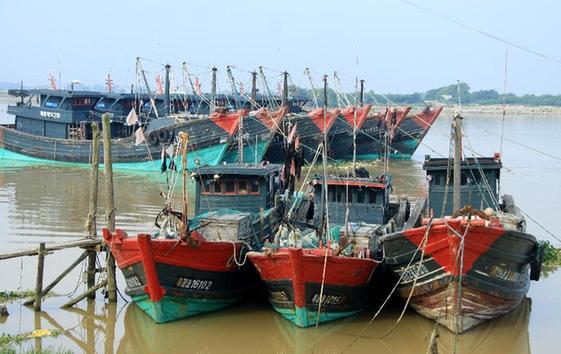China's sovereignty over South China Sea indisputable
- By Chu Hao
 0 Comment(s)
0 Comment(s) Print
Print E-mail China.org.cn, May 23, 2012
E-mail China.org.cn, May 23, 2012
In recent years, the South China Sea issue has received increased attention. Opposing stances from Vietnam and the Philippines have at times escalated confrontation, bringing South China Sea into focus in the domestic and international media.
|
|
|
Vessels anchor in Batou Township of Denghai District in Shantou, south China's Guangdong Province, May 15, 2012. China will soon impose a routine fishing ban in northern parts of the South China Sea, authorities announced Monday. The fishing ban will last from May 16 to August 1, covering areas north of the 12th parallel of north latitude, including Huangyan Island but excluding most of the Nansha Islands, according to a spokesman from the South China Fishery Administration Bureau of the Ministry of Agriculture. [Xinhua/Yao Jun] |
The semi-enclosed South China Sea, one of the three Asian marginal seas, lies between the Pacific Ocean and the Indian Ocean. Stretching more than 1,800 km from north to south and 900 km from?west and east, the sea covers about 3.6 million square kilometers. Accessible from all directions, it carries great strategic importance. The South China Sea issue refers to the disputes over territorial sovereignty, maritime delimitation and resource allocation among China and several southeastern Asian countries. Most of the disputes are related to the Nansha Islands, so the "South China Sea issue" is also called "Nansha Dispute."
China's full sovereignty over South China Sea has a sufficient historical basis, further supported by international law.
As early as the 2nd century BC, ancient Chinese originally discovered the Nansha Islands. With the development of the maritime industry, the Nansha Islands started to attract attention. China renamed the South China Sea islands as "Changsha" during Tang and Song dynasties, when dozens of names vividly described the islands, sandbanks, reefs, waterways size, topography, and orientation in the South China Sea.
The Chinese people first developed and managed Nansha Islands. The Odds Contents of the 1st century BC and the Guangzhou Records by the Jin-dynasty Pei Yuan recorded Chinese fishermen's activities in South China Sea. In the Ming and Qing dynasties, more Hainan-Island fishermen made their way to Nansha Islands for fishing, and fixed operation lanes took shape. Furthermore, they also reclaimed the land and planted trees there.
In the 19th century, foreign navigators, based on the existing facts, admitted that it was Chinese people who originally developed and managed Nansha Islands. "Hainan fishermen, dotted on every island, live on sea cucumbers and shellfishes. Some of them also inhabit the islands," noted the British Navy's China Sea Guide.
China was the first country that exercised jurisdiction on South China Sea. The Zheng He Navigational Charts in the Ming Dynasty shows a record of the Nansha Islands. Two Qing-dynasty maps in 1716 and 1817 also include the Nansha Islands into its territory, calling them "Wanli Shitang". In 1883, Germany stopped its investigation activities in Nansha Islands in the face of protest from the Qing government. In 1933, the French occupation of the Nansha Islands invited Chinese fishermen's resistance, after which the Chinese government made firm its claim to the territory. France evacuated at last. In 1946, the Chinese government, according to the "Cairo Declaration" and "Potsdam Proclamation," regained its sovereignty over the South China Sea islands and reefs and re-erected a monument of sovereignty on the main island.
In 1947, China made public the old and new name table of the South China Sea islands, which was put under the governance of Guangdong Province. In February 1948 the Chinese government released a "South Sea Islands Location Map" which was also re-adopted after the founding of the People's Republic of China. In 1951, the "Japanese Peace Treaty" draft and "San Francisco Conference Statement" announced by Chinese former premier Zhou Enlai pointed out that the "Xisha, Nansha Islands and Dongsha, Zhongsha Islands have always been Chinese territory." In 1958, China proclaimed the "Declaration on the Territorial Sea." Afterwards, in the face of violations by foreign countries, the Chinese government has, on many occasions, reiterated its indisputable sovereignty over the Nansha Islands.
The international community and the dispute-involved countries further confirm China's absolute sovereignty over the South China Sea. According to hosts of diplomatic documents, even Vietnam has, repeatedly and explicitly, acknowledged the Xisha and Nansha Islands as Chinese territory. Many maps published by many countries worldwide, including Romania, Spain and Japan, recognize Nansha Islands as Chinese territory.
Therefore, according to existing historical basis and the principle of discovery, the principle of first occupation and the principle of equitable estoppel in international law, China has indisputable sovereignty over Nansha Islands and their adjacent waters.
The author is from the South Asia, Southeast Asia and Oceania Research Center of Chinese Institute of Contemporary International Relations
Opinion articles reflect the views of their authors, not necessarily those of China.org.cn.






